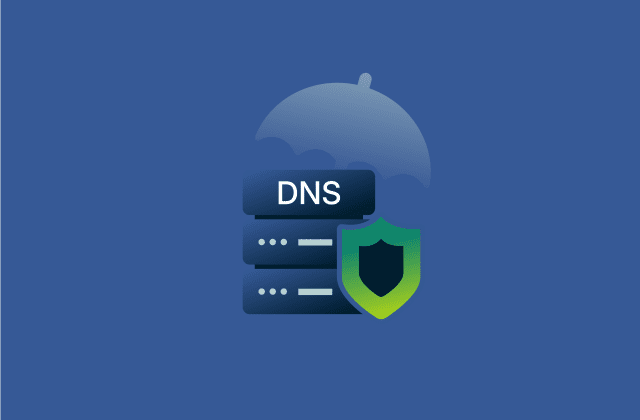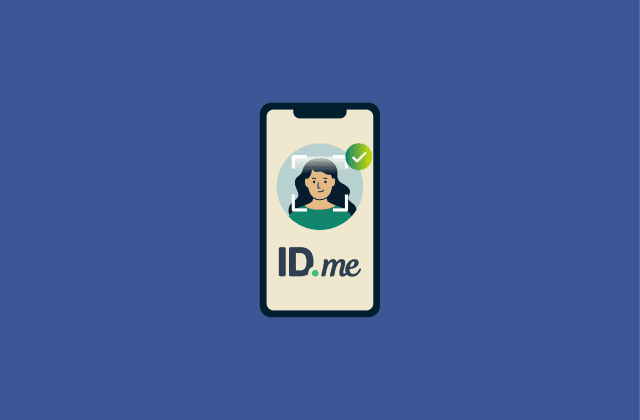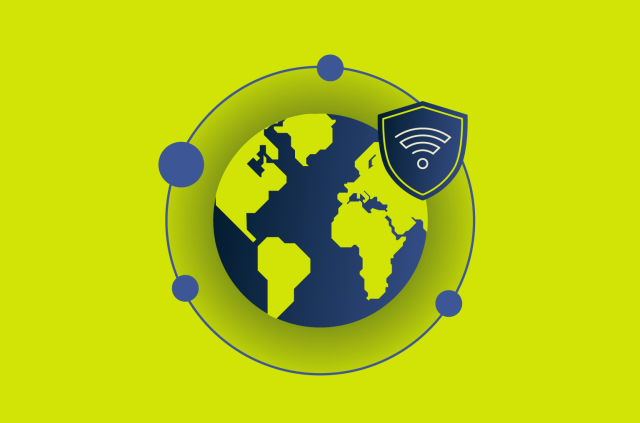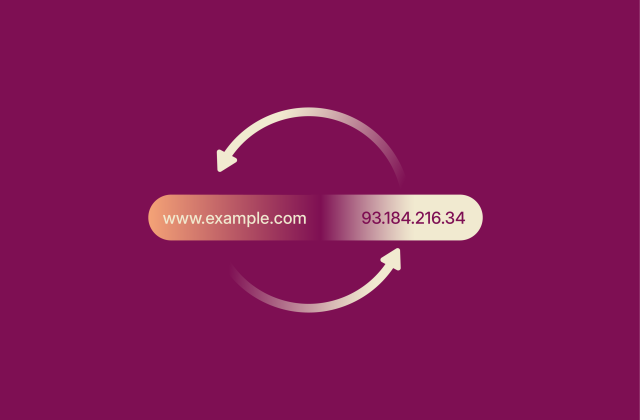A complete guide to MPLS VPN services for secure and reliable connectivity

In enterprise networking, the choice of how to connect offices, data centers, and remote users has a direct impact on performance, reliability, and cost. One solution is a multiprotocol label switching (MPLS) VPN, which provides secure, predictable connectivity across multiple locations.
This article explains what MPLS VPNs are, how they differ from traditional VPNs, the benefits and drawbacks they bring, and where they stand alongside emerging solutions like software-defined wide area networks (SD-WANs).
What is an MPLS VPN?
Unlike standard VPNs, which rely solely on the public internet, MPLS VPNs use a logically segregated network infrastructure provided by an internet service provider (ISP) to deliver private connections with consistent performance.
At its core, MPLS is about making data transport faster and more predictable by moving data along predefined routes. To understand how this works in practice, it helps to first look at how data normally travels across the public internet and why that process can be inefficient.
How data travels on the public internet
When you send an email, load a website, or stream a video, the information doesn’t move across the internet as one continuous flow. Instead, it is broken down into small units called packets. Each packet carries a portion of the data along with information where to send it.
As it travels, data goes from one router to another, each device examining the full destination address to decide where to send it next. Routers do this by consulting special databases called routing tables. Each router makes its own decision independently, so packets to the same destination might take different paths.
This process, known as IP routing, works well for a global and open network like the internet, but it has limitations. Each router must perform a separate lookup for every packet, which takes time and processing power. As mentioned, the path that data takes is also not fixed: it can vary depending on network congestion or routing changes. This makes the internet flexible but not always predictable.
How MPLS works
MPLS changes how data moves across the internet. Instead of relying on each router to make a routing decision at every step, MPLS assigns a short label to each packet when it enters the network through a provider edge (PE) router.
The PE router determines which predefined path, or label-switched path (LSP), the packet should follow and attaches the appropriate label. Note that label-switched paths are established in advance by the network operator.
As labeled packet travels through the provider’s core routers, known as P routers, these devices only read and swap labels rather than performing full routing lookups. Because intermediate routers don’t need to examine the entire IP header or run complex routing decisions, packets move through the network more quickly and predictably, resulting in faster forwarding and consistent performance. (This is also the reason MPLS is called multiprotocol: it can carry different types of network layer protocols over the same infrastructure. Unlike traditional IP routing, which is designed specifically for IP packets, MPLS does not “care” whether the traffic is IP, Ethernet, ATM, or even legacy protocols because P routers only read the label of each packet.)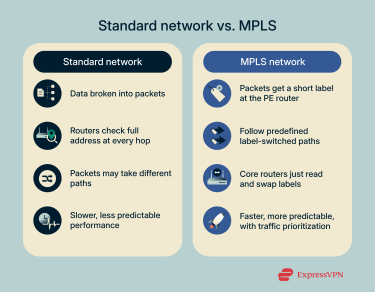
How MPLS creates a VPN
While the term VPN often brings to mind encrypted tunnels over the public internet, an MPLS VPN operates differently. The VPN, in this context, isn’t a separate technology that MPLS depends on. Rather, the VPN is the result of how the MPLS network is configured: it’s the logical separation that makes each customer’s traffic private within the shared backbone, not encryption.
This isolation is achieved using a technique called virtual routing and forwarding (VRF). VRF creates a separate routing table for each customer, ensuring that packets from one organization never mix with those of another, even though they share the same physical infrastructure. In practice, this gives each customer the experience of having a dedicated private network, even though they are all connected through the same provider backbone.
Strengths and limitations of the MPLS approach
There are several pros and cons when it comes to MPLS VPNs. Here are the main aspects to consider.
MPLS strengths
MPLS offers several benefits for organizations over standard networks. By sending data along dedicated paths instead of the public internet, it keeps traffic secure by isolating it.
Because MPLS uses predetermined routes, network operators can also prioritize certain types of traffic, such as Voice over Internet Protocol (VoIP) or video conferencing applications, so they run more smoothly. Finally, the same predefined paths make performance more consistent and predictable, reducing latency and minimizing interruptions.
MPLS limitations
MPLS has some trade-offs. It’s more expensive than a standard internet service, which can make it less accessible for smaller organizations. Setting up an MPLS network also takes a lot of time, which can make it harder for organizations to scale their networks quickly.
Additionally, MPLS can be complex to manage. Because it’s typically provided as a managed service, organizations with networks that span multiple regions may need to work with different providers to cover all areas, which can make coordination more challenging.
Lastly, organizations that rely heavily on cloud services may need extra configuration to connect MPLS directly to specific cloud servers, because MPLS provides dedicated paths within the service provider’s network, but doesn’t automatically extend to third-party cloud infrastructure.
Types of MPLS VPNs
MPLS VPNs are offered in two main types that operate on different network layers and are designed to meet varying business needs: Layer 2 (L2) VPNs and Layer 3 (L3) VPNs. The main difference is how much of the routing and network management the provider handles.
Layer 2 MPLS VPNs
Layer 2 VPNs act like a private “cable” connecting your company’s sites, making them feel as if they’re on the same local network, even across distances.
These VPNs come in two forms:
- Point-to-point connections (VPWS): Connects two sites directly.
- Multipoint connections (VPLS): Connects multiple sites in a way that feels like they’re on the same local network.
With Layer 2, your IT team controls how traffic moves within the network, while the provider ensures it travels securely across their backbone.
Layer 3 MPLS VPNs
Layer 3 VPNs operate at the network level, with the provider managing how data is routed between sites. Each site operates as if it were on a dedicated network, but the provider handles the routing behind the scenes.
Key differences between L2 and L3 VPNs
The main differences between Layer 2 and Layer 3 MPLS VPNs are control, complexity, and scalability. Layer 2 VPNs give organizations more control over traffic movement between sites, but managing routing remains the responsibility of the company’s IT team. Layer 3 VPNs shift that responsibility to the provider, simplifying network management and making it easier to connect multiple sites or expand the network over time.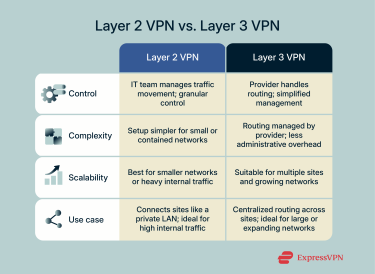
In practice, this means Layer 2 setups are often simpler and well-suited for smaller environments or networks with heavy internal traffic that doesn’t require complex routing. Layer 3 VPNs are more scalable and ideal for organizations with numerous sites or rapidly growing networks, where centralized routing and provider-managed infrastructure reduce administrative overhead.
MPLS VPN vs. traditional enterprise VPNs
The main difference between MPLS VPNs and traditional enterprise VPNs such as site-to-site VPNs is the way they move data across the network. Both create private, secure connections over a service provider’s network, but MPLS VPNs use labels to guide data packets along predefined paths, while traditional enterprise VPNs rely on standard IP routing.
Here’s a quick comparison between MPLS VPNs and traditional enterprise VPNs across key dimensions.
| Feature | MPLS VPN | Traditional enterprise VPN |
| Speed and performance | Consistent, low latency; private backbone; priority for critical apps | Varies with internet quality; encryption adds overhead; susceptible to jitter |
| Security and privacy | Segregated traffic; limited external exposure; no default encryption | End-to-end encryption; protects over untrusted networks |
| Cost | Higher: dedicated infrastructure, provisioning, managed service | Lower: uses existing internet; mainly hardware/software costs |
| Flexibility and ease of use | Slower to scale; requires provider coordination | Quick to add users/sites; more control; cloud-friendly |
Below is a more detailed breakdown with regard to speed, security, cost, and flexibility.
Speed and performance
MPLS VPNs usually provide more consistent performance than traditional enterprise VPNs. Traffic moves along predefined label-switched paths, which reduces processing overhead, latency, and network jitter. This makes MPLS well-suited for real-time applications like VoIP, video conferencing, or other time-sensitive workflows.
Providers can also enforce rules to prioritize critical applications, ensuring smooth communication even during heavy use. Finally, because MPLS relies on a private backbone rather than the public internet, it avoids congestion, unpredictable routing, and the performance variability that often affects conventional VPNs, both enterprise and consumer ones.
Security and privacy implications
MPLS VPNs provide security by keeping data within the provider’s private network, isolating it from other customers and reducing exposure to external threats. That said, they don’t encrypt traffic. For sensitive data, enterprises may need to add encryption layers such as Internet Security Protocol (IPsec).
MPLS VPNs don’t typically use protocols like WireGuard because they already provide private, routed connections as part of their setup, and because protocols such as WireGuard are optimized for internet-based VPNs rather than carrier-grade technologies.
Traditional VPNs for work, on the other hand, do secure data with end-to-end encryption. This protects communications even over untrusted networks and ensures that data remains secure from external attacks, even though it's traveling over public networks.
Cost considerations
MPLS VPNs generally have higher costs because they rely on dedicated infrastructure managed by the provider, which involves provisioning, specialized equipment, and ongoing service management.
Traditional VPNs are typically less expensive, as they operate over the public internet and use existing network links. Costs mainly come from encryption hardware or software and network management, with minimal reliance on provider-managed circuits.
Flexibility and ease of use
MPLS networks are tied to the service provider’s infrastructure, which can limit agility. Adding a new site or expanding bandwidth often requires coordination with the provider and hardware changes. This process can take weeks, making rapid changes or cloud integration less straightforward.
In contrast, traditional VPNs, especially cloud-friendly solutions, allow organizations to scale quickly. New users or locations can be added through software and internet access, without waiting for physical circuits.
Traditional VPNs give organizations more control over routing and IP management, and cloud-based VPNs can extend private networks flexibly, supporting dynamic growth and frequent infrastructure changes.
MPLS VPN vs. SD-WAN
A software-defined wide area network (SD-WAN) is a software-driven network that optimizes traffic across connections. MPLS VPNs and SD-WAN both enable connectivity between multiple locations, but they use different methods for routing and managing traffic. MPLS relies on fixed, provider-managed circuits, while SD-WAN is software-driven and can leverage multiple transport options, including the internet, LTE/5G, and MPLS itself.
Key differences in architecture and use
As we’ve seen above, MPLS VPNs use dedicated circuits at each site, sending data along predetermined paths. This setup provides reliability and predictable performance, but expanding an MPLS network usually involves hardware changes, provider coordination, and long provisioning times.
SD-WAN, on the other hand, is software-based and much more flexible. It can automatically select the best path for each data packet, whether over broadband internet, LTE/5G, or an existing MPLS link. It does this based on policies, application requirements, and real-time network conditions, sending less critical traffic over cheaper links while reserving higher-quality paths for sensitive applications. This makes it easier to scale, manage multiple sites, and adapt to changing network demands without waiting for physical infrastructure changes.
Which is more suitable for remote teams?
For organizations with remote or distributed employees, SD-WAN generally offers a more agile and cost-effective solution. It allows new users or locations to be added quickly through software, while automatically optimizing connections to cloud applications and corporate resources. Security policies can also be applied directly at the edge, protecting traffic without routing everything through a central data center.
MPLS can still support remote teams, but it often requires routing traffic through the main office or data center, which can introduce latency and reduce performance for cloud-based tools. As a result, many organizations adopt a hybrid approach, keeping MPLS for critical on-premises sites while using SD-WAN to provide efficient, secure connectivity for remote or cloud-focused users.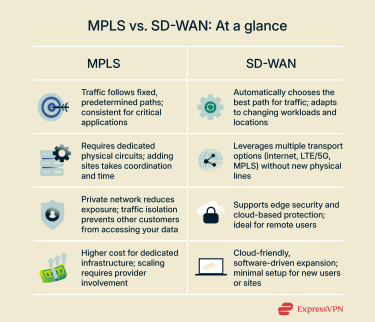
How to choose the right MPLS VPN service
Selecting an MPLS VPN provider is a long-term business decision. The right choice can make a difference in speed, reliability, and long-term flexibility. Here are some factors you should consider when doing your initial research:
- Network reach and reliability: If you operate across multiple sites or regions, your provider’s coverage will affect how well you can connect offices and data centers without latency or bottlenecks.
- Deployment and management capabilities: Some providers can roll out new circuits or hybrid connections quickly, while others may take months. Strong monitoring and 24/7 customer support can also help minimize downtime when problems arise.
- Scalability: Your provider should support growth, whether that means adding sites, expanding bandwidth, or blending MPLS with internet or SD-WAN links as your needs evolve.
Once you’ve identified providers that meet these baseline requirements, it’s important to take a closer look at the pricing models, quality-of-service guarantees, and service-level agreements (SLAs) they offer.
Cost models and pricing structures
MPLS is usually more expensive than internet-based options, but what really matters is how the provider structures those costs. Pricing typically covers setup, equipment, recurring service charges, and maintenance. When choosing a provider, make sure you understand exactly what’s bundled in and what may cost extra.
Some vendors offer flexible models, such as pay-as-you-grow bandwidth or hybrid options that route less critical traffic over cheaper links. These approaches can help you avoid overpaying for unused capacity and give you more room to scale without major contract renegotiations.
QoS, SLAs, and reliability considerations
MPLS can support Quality of Service (QoS) mechanisms that allow you to prioritize traffic from critical applications. When evaluating providers, check whether they actively implement traffic management to maintain consistent performance for high-priority operations.
Strong service-level agreements (SLAs) are essential. Compare providers’ uptime guarantees, latency expectations, and response commitments, and look at their track record for meeting these targets.
Reliability also depends on redundancy measures, such as backup links or duplicate systems, which help maintain consistent service even if part of the network fails.
Common use cases for MPLS VPNs
The following examples highlight the most common scenarios where MPLS is used.
Securing remote work connections across locations
Enterprises with multiple branch offices often rely on MPLS to connect employees and systems to central data centers. Deterministic routing ensures that data packets follow consistent paths, keeping network performance steady regardless of traffic load. Retail chains, financial firms, and healthcare providers use MPLS to link point-of-sale (PoS) systems, databases, and other applications securely across locations, simplifying network management and reducing latency-related issues.
Improving VoIP and streaming performance
Time-sensitive workloads, like voice calls, video conferencing, and live data streams, can be disrupted by latency or jitter spikes. MPLS helps by assigning guaranteed bandwidth and prioritizing critical traffic, keeping video calls clear, streaming data uninterrupted, and real-time applications functioning reliably even during periods of high network demand.
Connecting multi-site enterprise networks
Large organizations, particularly those in regulated industries such as finance, healthcare, and energy, use MPLS to build secure, scalable, and highly reliable wide area networks (WANs). These networks maintain data integrity, meet compliance requirements, and provide documented performance metrics, enabling multiple offices, R&D sites, or manufacturing facilities to communicate efficiently.
FAQ: Common MPLS VPN questions
Which type of MPLS VPN should I choose: L2 or L3?
Layer 2 (L2) and Layer 3 (L3) multiprotocol label switching (MPLS) VPNs serve different business needs. L2 VPNs provide a private connection between sites, making each location feel like it’s on the same local network, while L3 VPNs shift routing responsibilities to the provider, simplifying network management and scaling across multiple sites. Choose L2 if you need tight control within a smaller network, or L3 for enterprise-wide networks with many locations.
Can MPLS support remote workforces?
Yes, multiprotocol label switching (MPLS) VPNs can support remote workers, but traffic often needs to be routed through central offices or data centers. This ensures security and predictable performance for on-premises corporate applications. However, because cloud-based applications may not be directly connected via MPLS, organizations often use software-defined wide area networks (SD-WANs) or internet VPNs alongside MPLS to efficiently handle remote or cloud-focused traffic. Many adopt this hybrid approach to maintain performance for both on-site and cloud users.
Does MPLS VPN work with cloud services like AWS or Azure?
Multiprotocol label switching (MPLS) VPNs can connect to cloud services, but it usually requires additional configuration, since MPLS provides dedicated paths within the provider’s network and doesn’t automatically extend to third-party cloud providers. Organizations often integrate MPLS with software-defined wide area networks (SD-WANs) or other hybrid solutions to optimize cloud connectivity, reduce latency, and maintain security while using services like AWS or Azure.
Take the first step to protect yourself online. Try ExpressVPN risk-free.
Get ExpressVPN






